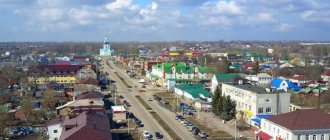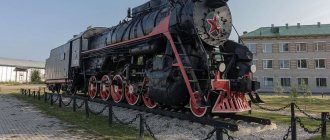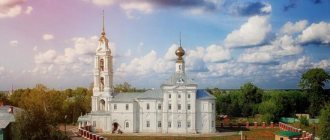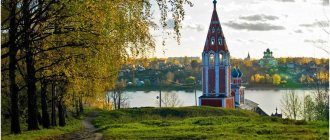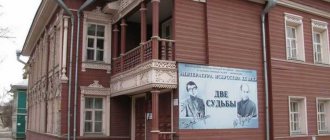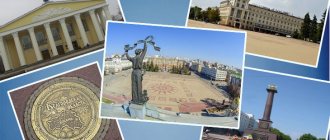Navlya
, an urban-type settlement in Russia, the administrative center of the Navlinsky district of the Bryansk region, within the Bryansk diocese. Located on the Navlya River, 45 km south of Bryansk. Railroad station; The international highway “Ukraine” runs along the southwestern outskirts of the village. Population - 14.2 thousand (2010).
- On the map: Yandex.Map, Google map
According to one version, the name is Navlya
interpreted as an adjective from the ancient Slavic word “nava” - mermaid.
The village arose in 1904 at the station, in connection with the construction of the Moscow-Kievo-Voronezh railway at the end of the 19th century. At the beginning of the century, the Tsar’s brother, Grand Duke Mikhail Romanov, opened a distillery here, which produced raw alcohol for the Brasov princely distillery. In 1914, the Russian-Danish-German society “Julius Judgers” opened a sleeper impregnation plant in Navla.
On May 30, 1924, Navlya became the center of the Navlinskaya volost of the Bezhitsky district of the Bryansk province. On June 17, 1929, the Navlinsky district was formed as part of the Bryansk district of the Western region (since 1937 - in the Oryol region, and since 1944 - in the Bryansk region). During the years of the first five-year plans, a number of factories were built, and social and living infrastructure was developed. On December 4, 1938 it received the status of a workers' village.
During the Great Patriotic War, Navlya and the region became centers of the people's struggle against the Nazi invaders. In July 1941, a fighter battalion was created in the village, and on the eve of the occupation, a partisan detachment was created. The German occupation lasted from October 6, 1941 to September 7, 1943, during which time 22 partisan detachments fought on Navlina soil.
After liberation, Navlya lay in ruins, but the restoration of the economy proceeded quickly. In the 1960s, Navlya turned into one of the well-developed industrial and socio-cultural centers of the Bryansk region: it had 11 enterprises, a new high school, a cultural center, a children's and youth sports school, a cinema, a stadium, and a department store. In 1970 it became an urban village.
Statistics
- 1917 - 117 people
- 1924 - more than a thousand people, 124 houses
- 1938 - approx. 7 thousand people, 1180 houses
Notes
- ↑
Population of the Russian Federation by cities, urban settlements and regions as of January 1, 2010 - ↑
A wall of memory has been opened in Navla. // briansk.ru. Archived from the original on February 12, 2012. Retrieved April 28, 2011.
- Narrow gauge railway of Navlinsky sleeper-impregnated Sergei Bolashenko
Moscow | DSK "Michurinets"| Vnukovo | Forest Town | Kokoshkino | Village of Kryokshino station | Village of the state farm "Krekshino" | Aprelevka | Alabino | Selyatino (urban village) | Selyatino (village) | Rassudovo | Bekasovo | Alexandrovka | Naro-Fominsk | Vorsino | Balabanovo | Obninsk | Shemyakino | Maloyaroslavets | Erdenevo | Goncharovka | Detchino | Jubilee | Tikhonova Pustyn | Kaluga | Vorotynsk | Babynino | Kudrinskaya | Sukhinichi | Duminichi | Palicki | Solonovka | Zikeevo | Sudimir | Berezovsky | Batagovo | Lesnoye | Bryansk | Coupling | Sinezerki | Privolye | Klyukovniki | Navlya | Altuhovo | Kokorevka | Kholmechi | Nerussa (station) | Nerussa | Suzemka |
Attractions
In Navlya there is a museum of partisan glory, a square of underground partisans, a monument “Wall of Memory” of members of partisan detachments with a bust of the commander of one of them, Pyotr Derevyanko [13], as well as a monument to soldiers of the 10th separate tank brigade of the Bryansk Front (installed on a heavy pedestal tank IS-2). In addition, in the village there is a monument to Lenin, a stele in honor of the liberation of the village, a monument and burial place for the defenders and civilians of Navli on the station square. In the park of culture and recreation named after. Knyazev there is a monument to the defenders of the village in the park named after. Derevianko is a monument to the liquidators of the Chernobyl accident.
Navlya | Where history says... - BezFormat.Ru
- Monuments are a symbol of glory and eternal memory of soldiers who gave their lives for the freedom of our Motherland. Monuments are not silent, they speak. They force us not only to remember the terrible events of wartime, to respect the memory of those who died, but also to think about the future, to love our Fatherland. Today we will touch upon the history of only a few memorable places in Navla, which do not allow us to forget the terrible experience of the hard times of war received by our older generation - the generation of liberators and victors.
One of the first memorial places formed in the village of Navlya was the mass grave on the former Lenin Square (this is the modern station square), where in 1937 - 1941 there was a monument to V.I. Lenin. After occupying the area in October 1941, the German invaders publicly demolished the monument to the leader of the world proletariat and installed a gallows in its place - they set up a place of execution. After the expulsion of the fascist invaders, the gallows in the lower square were demolished, but this place forever remained sacred to us. In 1946, the remains of dead partisans and civilians were transferred here, and a monument in the form of a brick stele was erected. And 16 years later, in 1962, a sculpture of a warrior in a cape holding a helmet in his right hand was installed on a brick pedestal with marble memorial slabs. The monument bears the names of the partisans and local residents buried at this site. In April 1952, a monument was unveiled in the M. Knyazev Culture and Recreation Park at the burial site of Soviet Army soldiers who died during the liberation of Navli from the Nazi invaders in September 1943. In 1962, on the pedestal of a mass grave, a concrete sculpture of a kneeling warrior was installed, in whose right half-bent hand there is a helmet, and in his left hand there is a bowed banner with a wreath at the pole. In 1971, three memorial plaques with the names of 84 Soviet soldiers of the 129th Infantry Division of the 63rd Army of the Bryansk Front appeared on the pedestal. On September 17, 1968, on the 25th anniversary of the liberation of the region from the Nazi invaders, a monument to liberating soldiers and partisans was erected in the form of a stele in the center of Navlya. Three years later, memorial plates were mounted on the obelisk, on one of which the text was placed: “The following took part in the liberation of the Navlinsky district from the Nazi invaders in September 1943: 129, 169, 84, 11th Infantry Divisions, 10th Guards and 35th Tank Brigade of the Bryansk Front under the command of Army General M.M. Popov.” The second plate contains the names of all 14 partisan detachments formed in our region in 1941 - 1943: “Death to the German Occupiers”, “People’s Avenger”, “Im. Parkhomenko", "im. Mikoyan", "named after. Zheleznyak", "Altukhovsky", "im. Zhdanov", "im. Kotovsky", "named after. Sverdlov", "named after. Kirov", "im. Sagittarius", "im. Krupskaya", "Zhuravsky", "im. Shaumyan." The third plate depicts the Order of the Patriotic War, 1st degree. In 2010, in the center of Navli, a monument was unveiled to the commander of the Kirov partisan detachment of the “Death to the German Occupiers” brigade, Honorary Citizen of the Navlinsky District P.I. Derevyanko. Pyotr Ilyich Derevyanko was born far from our place - in the village of Gannovka, Pavlograd district, Omsk region. In 1940 he graduated from the Omsk Infantry School. Frunze with the rank of lieutenant, a machine gunner by specialty. The war found Pyotr Ilyich in the city of Nezhin near Kiev. In the very first days after the attack by Nazi Germany, units of the 2nd Airborne Brigade, where Derevianko served, were sent to Kyiv, where they participated in the defense of the city. But in September 1941 they were surrounded, from which they had to break through to the front along forest paths. At the end of October we went to the Navlina village of Sidorovka, where the partisan page of his biography began for Pyotr Ilyich. The entourage was accepted into the “Death to the German Occupiers” detachment, and Derevianko was appointed platoon commander. And in December 1942 he became the commander of the partisan detachment named after. Kirov brigade "Death to the German occupiers". For his great contribution to the liberation of the Navlinsky district from the Nazi invaders, the organization of the partisan movement in the region, and active work in the military-patriotic education of youth, on August 8, 2000, P.I. Derevianko was awarded the title of Honorary Citizen of the Navlinsky District. (Based on materials from the Museum of Partisan Glory) Photo by Irina Kharitonova
Did you like the article? Recommend her to your friends!
navlya.bezformata.ru
Navlya village in 1941-1945
Navlinsky district during the Great Patriotic War of 1941-1945. On June 22, 1941, Germany attacked the Soviet Union, and the Great Patriotic War began. On June 24, 1941, a Resolution of the Council of People's Commissars of the USSR was issued, on the basis of which the Oryol Regional Committee of the All-Union Communist Party (Bolsheviks) and the executive committee of the regional Council of Workers' Deputies decided to form destruction battalions in the regions of the region. The battalions carried out tasks to combat enemy saboteurs, train fighters and commanders to conduct combat operations behind enemy lines. NKVD employees were selected for the positions of commanders of destruction battalions, and party workers and the best representatives of the party and economic activists of the districts were selected for the positions of commissars.
Bryansk region Navlinsky district
Navlinsky municipal district is an administrative unit in the east of the Bryansk region of Russia. The administrative center is the urban-type settlement ► Navlya. The area of the district is 2030 km². The main rivers are Navlya and Revna. The population of the district is 28.2 thousand people, including about 16 thousand living in urban areas. There are 86 settlements in total. The largest of them are Navlya and Altukhovo.
Agriculture, agro-industrial complex, farmers of Navlinsky district.
Dobronravov Agro SPK RYABCHEVSKY .
Peasant farm "Gordeev" Zubovskoe A. Novikov and T. Kirichenko .
► History of Navlinsky district
► Attractions Navlinsky district
Sights of the Navlinsky district of the Bryansk region
Memorable places associated with the Great Patriotic War
Komsomol underground members
Alexander Vasilyevich Suslin was born in 1908 in Petrograd. In 1918 seven
I moved to Moscow. Alexander was a carver and cutting instructor at the Goznak factory. He was elected secretary of the workshop party organization and headed the propaganda department of the factory party committee. He was an instructor at the Leningrad district committee. He graduated from the Sverdlov Komversary College and received a position as the head of the political department of the Krupskaya state farm in the Navlinsky district. In 1937, he was elected secretary of the district committee and member of the regional committee. When the war began, Suslin headed the Navlinsky underground district committee and district committee. Alexander Vasilyevich was tall. Long black hair combed back, with gray at the temples, a clean-shaven, weathered face, black eyes, a thoughtful look from under high eyebrows. A khaki-colored tunic, from under the collar of which a snow-white collar was visible, black cloth trousers with red piping, simple cowhide hunting boots, a sword belt on the right side, and a revolver in a holster.
Sources:
https://dic.academic.ru/dic.nsf/ruwiki/107871 https://wiki-org.ru/wiki/%D0%9D%D0%B0%D0%B2%D0%BB%D1%8F_( %D0%91%D1%80%D1%8F%D0%BD%D1%81%D0%BA%D0%B0%D1%8F_%D0%BE%D0%B1%D0%BB%D0%B0%D1 %81%D1%82%D1%8C) https://www.br-navlya.ru/
Navlya - settlements and river, etymology
And into the Desna River, on the left side, below Trubchesk, the Nerusa River fell, and into the Nerusa River the Navlya River fell. Book to the Big Drawing, 1627, p. 85; https://www.prlib.ru/item/417685 There is an error in this message of the ancient geographer, the Nerusa River really flows into the Desna below Trubchevsk, the Navlya River flows into the Desna above Trubchevsk. 1) Hydronyms
a) Navlya is a river that flows through the Oryol and Bryansk regions. The length is 126 km, the channel is winding, the depth is 0.5-2 m. It flows into the Desna River, from the source to the mouth there is a wide swampy and meadow floodplain, it receives 45 water streams, the banks are often steep 3-6 m. The river basin is densely populated, more 30 settlements, most of the settlements are marked on maps of the 19th century. Shown on the General Survey Plan (GMP) of the Trubchevsky district of the Oryol province. 1785; Map of parts of Kursk, Tula, Oryol and other governorships in 1787. Trekhverstovka of the Bryansk region. Military topographical map of 1869
* Water of Russia/Navlya https://water-rf.ru/%D0%92%D0%BE%D0%B4%D0%BD%D1%8B... Navlya is a typical flat river with a winding sandy bed 6–15 m wide , current speeds 0.2–0.5 m/s. The floodplain is swampy, wide, up to 3–5 km wide. In the XVIII–XIX centuries. The forest floodplain of the Navli, thanks to intensive haymaking and grazing, was transformed into a meadow; forest areas were preserved only in the lower reaches. Etymology. There are several versions of the origin of the name of the river. According to one of them - from the Slavic nava - “mermaid” and navya - “little mermaid” (???).
* ESBE/Novlya, Navlya
Novlya (or rather Navlya) is a tributary of the Desna River, the flow length is more than 110 ver., flows through the western districts of the Oryol province. It originates in Karachevsky district with several streams in the vicinity of the villages of Molodovoy and Shablykina at a latitude of 52°52′. ... The general direction of the current is from E to W. It cuts through the middle part of Karachevsky district, approximately at latitude 52°52′, passing through large villages: Shablykino, Novoselki, Yablochkovo, Samovo. Here the river flows all the time among treeless spaces. But in the upper reaches, a huge area of the coasts of the N. and Belousovka streams up to the Kremlin is occupied by Molodov forests. ... From the villages of Gremyachey and Sychevka in the east to Samov inclusive, on the banks of the N. there is a huge layer of sand (thalweg), often up to 2 centuries wide, overflowing with abysses, peat bogs and hidden springs and occasionally covered with small growths of bushes. ...The flow of the N. River, rich in water and having a fall of about 35 fathoms per 110 centuries, is completely unregulated. A strong flood in the spring at the very beginning of April carries away a lot of water and, at an enormous flow rate, carries heaps of sand, which clog the riverbed of the Desna, and then the Dnieper. ...The river is floatable only in the spring; Mills especially interfere with rafting in the summer. Along the lower reaches of the N. River there are huge pine forests. In the spring, the forest rushes to Kyiv.
b) Bolshaya Navlya - a small river in the Smolensk region, a tributary of the Ostra, swampy and meadow floodplain, flows into a forest, length approx. 17 km. The Bolshaya Navlya receives 10 water streams, the Malaya Navlya tributary receives 3 water streams. Shown on the Detailed Map of the Russian Empire and nearby foreign possessions in 1816 - Navlya. On Trekhverstovka, Bryansk region. The military topographic map of 1869 shows swampy and meadow floodplains, three settlements. On the Red Army Map N-36 (G) • 1 km. Bryansk, Kaluga and Orel regions. 1941
2) Toponyms
a) Navlya urban-type settlement Navlinsky district, Bryansk region. Founded in 1904 in connection with the construction of the Moscow-Kiev-Voronezh railway. On Trekhverstovka, Bryansk region. The military topographic map of 1869 shows only the Navlya railway station on the site of the village.
b) Navlya village, Shablykinsky district, Oryol region, located at the source of the Navlya River. Shown on the General Map of the Oryol Province of 1801 - Navlya; on the Big Map of the Russian Empire of 1812 for Napoleon - Alekseevskoye or Navlya. On the Detailed Map of the Russian Empire and nearby foreign possessions in 1816, - Alekseevskoye, Navlya, etc. On Schubert's map of 1832, 65 courtyards, church.
* Wikipedia comment: “The outdated name is Navl. It has been mentioned since the first half of the 18th century as a village with the Alekseevskaya Church, the former possession of the Rzhevskys, and in the 19th century - of the Chirkovs and others.” From archival documents it is known: “The inscription on the large bell of the Navlinskaya church shows that this village in 1773 was called Alekseevsky. The village received its modern name from the source of the Navli River. Navlya - from the Old Church Slavonic language means “mermaid”.
*** Note Rusalka - Navka; the term of folklore could not be found in Old Russian and Old Russian reference literature. * I.I. Sreznevsky. Materials...; https://etymolog.ruslang.ru/doc/sreznevskijL-O.pdf Nablom, navla, navlya - a musical instrument (biblical).
3) Generalization and conclusion
It was not possible to find hydronyms and toponyms of Navlya in the Old Russian acts; the term “Navlya” has no meaning in the Russian language. The Navlya River is mentioned in the Book of the Big Drawing of 1627, its geographical location is not indicated precisely. Hydronyms have been recorded on topographic maps since 1785, the toponym Navlya since 1801.
Conclusion It is advisable to consider hydronyms in connection with biblical images and terminology. We have a similar toponym - Nevel (Nevl, ca. 1580), located near Lake Nevel and the Emenka River (old Emenitsa) flowing into it. The toponyms NAVLYA and NEVEL have the same consonant signs, the common root is N.V.L., they are identical.
5) Hebrew terminology and biblical image
a) Terminology
Let's bring the hydronym (toponym) into a form close to Hebrew grammar, and highlight the root - NAVLYA = NAV+LYA. We immediately “float out” the Hebrew root N.V., NAVA flow out, pour out, stream.
* NAVLYA = NAV+LYA = Hebrew root.
N.V., NAVA נָבַע, form NOVEA נֹבֵעַ to flow out, pour out, flow, flow, flow with a spring (output of a stream of water) + LE accessory. The name indicates the hydrological characteristic of a river with an extensive swampy floodplain that collects many water flows into one large water flow. Corresponds to reality, the hydrological regime of the river having 45 water tributaries and a swampy floodplain (underground springs). Most likely, the name NAVLYA contains the idea - KEY or SPRING (river). See “Navlinsky springs” near the village of Navlya; https://svyato.info/brjanskaja-oblast/navlinskijj
-... Source * See Lexicon according to Strong and Butler Strong's number: H5042. Original: נבע. Pronunciation: naba‛. Part of speech: Verb. Etymology: primitive root - A(qal): to flow with a stream, to flow. E(hi): flow like a stream; flow; trans. utter, proclaim, utter. * See Strong Hebrew 5042 NAVA; https://beta.studylight.org/lexicons/hebrew/5042…. b) Biblical image
* Proverbs 18:4: “The words of men’s lips are like deep waters; the source of wisdom is a flowing (NOVEA, from NAVA, flow out, pour out) stream.” * Proverbs 1:23: “Return to my reproof: behold, I will pour out (NAVA) my spirit upon you, I will declare my words to you.”
Thus, the hydronym NAV+LYA is transliteration, the transfer of a biblical word and image by another alphabetic system (closer and closer to God). Characterizes the water regime of a river that has an extensive swampy floodplain, where the main source of power for the river is water flows and groundwater (underground) water.
Chisinau, July 27, 2020


